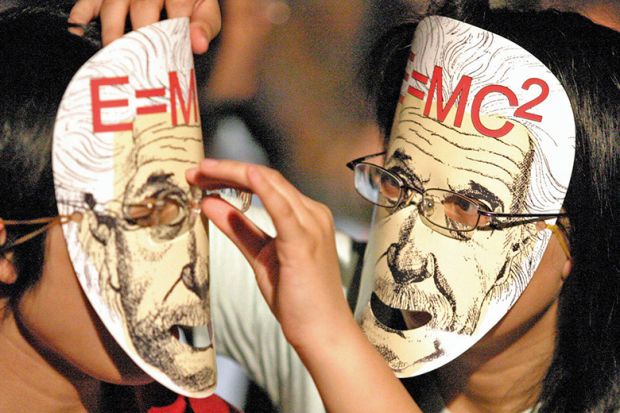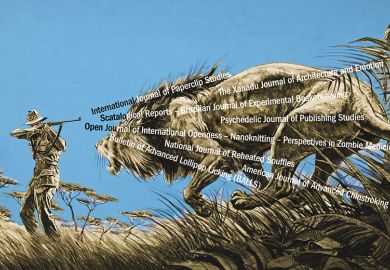A certain “international journal” of multiple disciplines recently sent me a “call for papers” explaining the journal’s attractive qualities and listing Terry Lamb, a renowned University of Westminster professor, as “chief editor”. Professor Lamb holds positions on many journals but he assured me he has never had any contact with this journal. When I asked the journal why his name was listed, I received no reply, but another person is now listed as its chief editor. The journal is an academic fraud – and, unfortunately, a typical one.
For instance, another international journal with a similar title sent me four calls for papers in the past year, all from different senders. The emails were signed by “Val Dusek, editor in chief”, who is listed on the website that way. Dusek, a well-published philosophy professor at the University of New Hampshire, told me he has never had anything to do with that journal.
The deceits practised by academic hoaxers are familiar, but the levels of deception are not so well known. Because I received many such emails from one Bangladesh-based outfit that recently appears to have been rebranded with an explicitly American name, I looked at the listed “editors-in-chief” of their 10 “journals”. For four of them, no one was named. For two, the person named did not exist at the institution provided. In three cases the scholars did exist but said they had nothing to do with the publisher.
I tried to contact other supposed editors-in-chief of similar publications who had contacted me but I found only one case where the scholar had ever had a connection to the “journal”: he had tried for years to have his name removed.
Below these imaginary editors-in-chief stand fictional editorial boards, typically composed of academics from across the world. Among the professors from North America, Europe, Africa and Asia who supposedly made up one 21-strong editorial board, about half confirmed to me that they did not give permission for their names to be used; the others did not respond. One listed editor – the feted literature professor James Boulton – died in 2013.
Many supposed editorial boards are simply cut and pasted from other “journals”. For instance, the names of nine academics including Boulton, plus others who assured me that they never gave their permission, appear letter-for-letter on the boards of several, all created by different “publishers”.
The websites of seemingly separate publishers show more unexpected overlaps, too. A quick Google search, for example, will reveal how many journals’ submission guidelines, from seemingly different publishers, contain the phrase “original papers, review papers, conceptual framework [sic], analytical and simulation models, case studies, empirical research, technical notes, and book reviews”.
These “journals” are typically labelled “predatory” but that phrase does not appropriately describe them. According to the conventional academic understanding of the word, there is no journal at all. Their websites list the articles in each “issue”, but there is nothing binding them together, either materially or conceptually. Since the “journals” typically cover the broadest possible range of fields, their “issues” are just random collections of pieces received in a particular month. And the typical accoutrements of academic journals are absent: cover, list of editors, table of contents. The difficult editorial work of putting out a journal is missing.
The “publishers” are not publishers at all. A better label for them is dishonest reformatters. A small number of people, misidentifying themselves and their organisations, merely reformat articles sent to them and put them on a website in exchange for a fee. That’s it.
So who publishes in such journals? I looked at the 58 articles in the seven issues of one catch-all journal in 2022. They come from all over the world, but very few from the advanced economies of the G7 nations or from top-tier institutions. The articles are short and read more like research notes than conventional journal articles. Depending on their country of origin, the English may be fluent or rough: there is no evidence of competent copy-editing. In a few cases, even the reformatting is a failure: in one article the spaces between words are missing.
However, these authors are unlikely to be predators or accomplices. Rather, they are victims of the pressure to publish, the difficulty of gaining access to respected journals and the new opportunities of open access. Penalising thousands of lesser-known academics would be inappropriate; discrediting their work would only reinforce the worldwide inequality of scholarly access.
Instead, university and governmental authorities should pursue regulatory action to protect scholars of all types across the world. For instance, one reformatter, Omics, was fined $50 million for deceptive business practices by the US Federal Trade Commission in 2018. Although this judgment probably can’t be enforced given that Omics is based in India, its publishing volume has declined 40 per cent since then.
Moreover, while one of the journals that spammed me produced 20 or more issues a year from 2011 to 2014, with 674 articles spread over 21 issues in 2014, just 58 articles appeared in seven “issues” in 2022. Other titles from the same publisher showed similarly precipitous declines between the mid-2010s and the present.
While this might be as a result of increased competition from hundreds of similarly named titles, warnings about reformatters’ business practices and their calls for papers may be having an effect. Concerted action can work: let’s keep it up.
Steve Hochstadt is emeritus professor of history at Illinois College.
Register to continue
Why register?
- Registration is free and only takes a moment
- Once registered, you can read 3 articles a month
- Sign up for our newsletter
Subscribe
Or subscribe for unlimited access to:
- Unlimited access to news, views, insights & reviews
- Digital editions
- Digital access to THE’s university and college rankings analysis
Already registered or a current subscriber?








